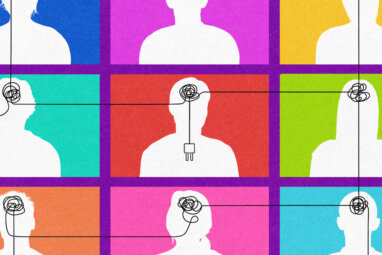Getting Smarter About Smart Buildings
Intelligent environments can make the workplace safer and improve collaboration.
Topics
Frontiers

Image courtesy of Daniel Hertzberg/theispot.com
We’re seeing renewed energy around smart buildings as organizations, their landlords, and developers consider what it will take to facilitate a mass return to physical workspaces mid- and post-pandemic. In particular, they’re thinking about how emerging technologies, beyond garden-variety sensors and apps, can be used to track employees and keep them safe. It’s increasingly possible, for instance, to analyze radio waves, like Wi-Fi, to monitor where people are and how they move — without any connection to a smartphone or other hardware.1 Employers and builders are also reconceiving optimal office design.2 A new global Smart Building Certification process is even underway.
However, in response to all this energy, one must ask: What will come of it? Is “smart” really getting smarter — and taking us where we want to go?
Smart environments have a long, deeply imperfect track record, dating back at least to the 17th century, when Dutch inventor Cornelis Drebbel created one of the first feedback-controlled devices: a thermostat that regulated airflow in a chicken incubator, based on temperature. Progress since then has been impressive, particularly in terms of efficiency (think energy and time savings), comfort or wellness (temperature, air quality, sound, lighting, and so on), and safety (detecting fire, revealing gas and water leaks, and other self-diagnostics).3 In that sense, we have achieved much of the promise of what were originally called intelligent (or automated) buildings at the end of the last century.4 But “smart” has also fallen short of our expectations in this century. We wanted smart homes that would work with us to anticipate and automatically address our day-to-day needs, but we’ve settled for connected homes that we manually control from our smartphones; we wanted smart cities that would run more efficiently by learning, predicting, and responding to our living patterns, but we’ve settled for large, underleveraged data sets.
There’s a pattern here, one that’s perhaps rooted in our dictionary definitions of smart. We use that word in two distinct ways, referring to human intelligence (our mental acuity) and device intelligence (tech’s capacity for predictive and independent, or automated, action). Until we integrate those definitions and make sufficient investments to integrate them in practice, not just in theory, our smart ambitions — for our workplaces as well as our homes and our cities — will remain elusive.
Such integration is not easy.5 On the one hand, human intelligence is currently ahead of device intelligence — our brains are still the best CPUs around. On the other hand, nonhuman processing power and device connectivity are expanding exponentially, whereas our brainpower is not. And while device intelligence benefits from predictable behavioral patterns, dramatically shifting behaviors prompted by unanticipated events like COVID-19 demonstrate our human tendency to defy prediction. But if we learn from the past and think big enough, smart buildings can play a key role in helping us figure out what work looks like in the coming months and years.
A Blueprint for Progress
Research and experience suggest four ways to move forward:
1. Rather than simply focusing on what sensors and automation can reveal and do by themselves, we should investigate how technology can safely promote collaborative, effective human interactions. Research has demonstrated that physical environments we think will stimulate collaboration don’t always do so.6 Smarter buildings, first and foremost, must be smarter about producing the types of meaningful human exchanges organizations and their employees want.7
Architects can help by designing hallways, stairwells, kitchens, and workspaces to flow so that people run into one another and interact. For example, the infamous Building 20 at MIT, believed to have produced more innovations than any other building on the planet, was designed “inconveniently” to require its occupants to walk along the spine of its five wings to go from one office to another, causing many productive hallway “collisions” along the way. Imagine how many more useful conversations might have happened sooner if some of that movement could have been directed by smart technologies.
A small number of buildings around the world are already experimenting with exactly that approach. And amid pandemic-related de-densification efforts, the potential for smart buildings to reduce the number of total interactions but retain the most valuable ones has taken on increased importance. The same electronic communication data (from emails, calendars, and instant messages) that allows an AI-based system to deliver news that is relevant to our immediate priorities, given who we are meeting with at the moment and what we are planning to discuss, could also guide us to collide with other people in our buildings or organizations who have knowledge that might be useful to us.
2. Rather than enhancing brick and mortar alone, smart buildings should be designed to improve both physical and virtual work. This year, the world began what has been described as the largest work-from-home experiment in history — and it has been more successful than predicted.8 As many organizations shift to hybrid work environments (with some employees working from home and others in office buildings, or with everyone alternating between the two), smart buildings could ease the transition. Yes, sensors can provide managers with data on employee whereabouts to keep people safe and socially distanced. But they can also help individuals make decisions about whether to come to the office or work from home — based not only on capacity constraints but also on whether the people we need to work with will be available in person or virtually.
A decade ago, researchers found that team members coordinated well and closely identified with the group when no one was colocated or when the same number of members worked in each location (say, two in one office and two in another). But when proportions weren’t balanced, teams suffered.9 Smart buildings could help us achieve balanced proportions across hybrid workspaces and solve some of the coordination problems that will be created as a subset of people head back to office-based work. Indeed, the most sustainable office building on earth — The Edge in Amsterdam — already does this, and while its occupants always found this useful given the dense population of the Netherlands, it is becoming even more so midpandemic.
3. Rather than generating data seen by “them” (that is, by managers, for the purpose of top-down supervision), smart buildings should yield data that’s visible to and used by “us” (by employees as well as their bosses, for coaching and development). What one might call a data bottleneck is a big barrier to smart getting smarter. Whether it sits untapped on servers or unanalyzed by managers, smart building data is woefully underused. In part, that’s because we’ve assumed that the best users of smart device data are the people who manage the devices, like those in our IT and facilities departments.
What if, instead, we viewed this data as akin to Fitbit data — information to help us better manage our own behaviors, individually and collectively? When the data “belongs” to someone else, the feeling of being observed reduces employees’ perceptions of autonomy and undermines creativity, productivity, and engagement. But studies show that people more often put it to effective use when everyone has open access to it.10
4. Rather than focusing on certifying buildings at birth — a process that’s managed by real estate developers, not employers — we should pay more attention to what we’re learning about effective work and how we can use technology to incorporate those lessons over time. This is ideally an ongoing cross-functional conversation that, at a minimum, includes both facilities folks and HR.
It is probably for this reason that organizations that have a single leader responsible for both of those functions, like Nationwide chief administrative officer Gale King, seem to be making more progress than others toward smarter buildings. When people with different backgrounds are separately responsible for human capital and physical capital, their key performance indicators, and sometimes their belief systems, are often in tension, generating arguments rather than progress. But when one person is accountable for both, fast experimentation and decision-making become more realistic.
These four changes remove barriers to collaboration and development and, in the process, shift the balance of power to the people doing the work. They put colleagues on more equal footing, regardless of location. They give everyone access to the data, so everyone gets a say in how it’s interpreted and used to make work better. They help us make progress toward being more productive.
In the spirit of making such progress, let’s not view smart as something a business school professor is best equipped to define today. Instead, let’s deepen our shared understanding of what that term stands for by combining human and device intelligence — and continually experimenting — to improve our collective intelligence. That’s ultimately what will make our buildings smarter, because it will also make us smarter.
References (10)
1. A. Khalili, A. Soliman, M. Asaduzzaman, et al., “Wi-Fi Sensing: Applications and Challenges,” The Journal of Engineering 2020, no. 3 (March 2020): 87-97.
2. J. Mudditt, “How Offices Will Change After Coronavirus,” BBC, May 14, 2020, www.bbc.com.








